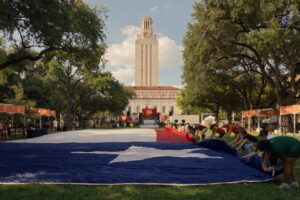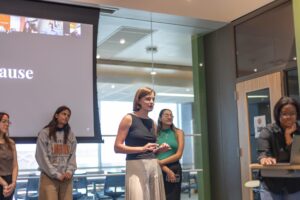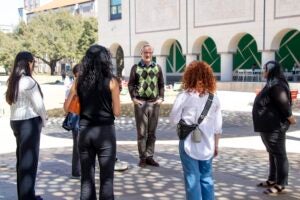The University of Texas at Austin will dedicate on Thursday, Aug. 28 a new $55 million Biomedical Engineering building, which is being touted as a world-class facility for interdisciplinary research and collaboration in biomedical engineering, pharmacy and natural sciences.
The 141,000-square-foot, six-story laboratory and research building was designed as the gateway to the university’s northern campus area. Its location creates a front door to the life sciences complex that includes the Neural and Molecular Science Building, the Louise and James Robert Moffett Molecular Biology Building and the future Experimental Science Building and the College of Pharmacy buildings.
The building will house classrooms, research laboratories and administrative offices of the Biomedical Engineering Department. In addition, the College of Natural Sciences and the College of Pharmacy will each occupy one floor, providing interdisciplinary strength to the already stellar department.
“The Biomedical Engineering Building is a magnificent new home for our faculty who are investigating scientific, engineering and medical challenges,” says William Powers Jr., president of The University of Texas at Austin. “It is the place where students will become the next generation to transform our world through innovation and discovery. By opening this building, we begin a new chapter for our university and for the future of scientific and technological research.”
Among the architectural features of the building are engaging scientific artwork engraved on the marble walls inside the lobby and a decorative pattern on the roof overhang which references the human genome.
The building houses nine optics labs built two stories underground to minimize the effects of vibration. A dozen wet labs, eight tissue-culture rooms, several dry labs and four computational labs also exist for medical research. The building becomes the first facility on campus with Leadership in Energy and Environmental Design (LEED) certification from the U.S. Green Building Council. Some of its sustainable features include a rainwater collection system, use of products with recycled content, carbon dioxide monitoring, and Greenguard-certified furniture.
Ben Streetman, Cockrell School of Engineering dean, says the new facilities will allow faculty and students to participate in advanced research and the study of applications of the biological sciences to human health.
“We will see breakthroughs by these researchers in medical imaging, nerve regeneration, cancer detection and treatment, drug synthesis and delivery, and countless other areas,” he says. “The building will also host work in pharmacy and natural sciences to provide interdisciplinary strength to these programs. We have one of the best biomedical engineering faculties in the country, and now these talented people will be able to work in one of the finest facilities devoted to biomedical teaching and research.”
Kenneth Diller, biomedical engineering chairman, says the work done in this new building will have a direct impact on saving lives and improving the quality of life for people who have cancer, glaucoma, diabetes, Alzheimer’s and other diseases.
“Our people–undergraduates, graduates and faculty–are absolutely superior in their qualifications,” he says. “So the building is designed to be a top-class environment for these people to thrive in. This department is and will continue to produce highly qualified student graduates as employees and the ideas that will drive innovations for the bio-tech industry.”
Funding for the building was provided by the state’s Permanent University Fund, the university, the Washington, D.C.-based Whitaker Foundation ($3 million) and the Cockrell School ($5 million.) The project architect was Parsons.
The University of Texas Department of Biomedical Engineering is a joint venture among The University of Texas at Austin, M.D. Anderson Cancer Center and the University of Texas Health Science Center (UTHSC) at Houston. It was established as a joint department spanning the three institutions on Sept. 1, 2006.
This multi-institutional effort combines the strength of one of the nation’s largest research universities with one of the top cancer research centers and a premier medical school, says Diller. This new department fosters an environment unique to the biomedical engineering community, and excels in both fundamental research and its translation to clinical applications.
Biomedical engineering has been a graduate program within the Cockrell School of Engineering since 1969. In fall 2001 it became a full academic department and now offers degrees at the graduate and undergraduate levels. The department has 465 undergraduate students, 110 graduate students and 18 primary faculty. Together with M.D. Anderson Cancer Center and UTHSC-Houston researchers, the faculty total approaches 25.
The Biomedical Engineering Building is at 107 W. Dean Keeton, at the southeast corner of Dean Keeton and University Avenue. A map is available online.
Learn more about the Department of Biomedical Engineering and the Cockrell School of Engineering.



